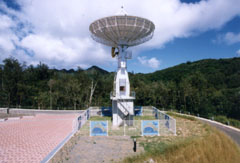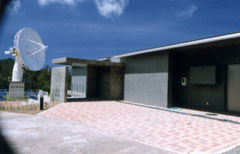

 |
||

|
Facility to Observe Crustal Movements Using
Radio Waves from Stars
 Very Long Baseline Interferometry, VLBI, is a technique to receive radio waves from radio objects (celestial objects emitting strong radio waves) deep in space by two or more antennas set at different receiving points and to accurately measure the difference of the arrival times of the waves. From this time difference, the geographical relation between two different receiving points can be figured out. Originally developed in the field of radio astronomy, the technology makes it possible to calculate the distance and deformation between two places 1,000 kilometers (621 miles) away to a tolerance of a few millimeters. In Japan, research and development of VLBI started in 1979 in cooperation with NASA, and the VLBI Experiment for Geodetic Application was launched in 1986. From the results of the VLBI observation at Chichijima Island in 1987 and 1989, the movement of the Philippine Sea plate which occasionally causes large earthquakes was verified by actual measurement for the first time.  Chichijima VLBI Observation Site was opened in August 1997 as the country's fourth permanent observation site. The other three are in Kashima City in Ibaraki Prefecture, Shin-totsukawa Town in Hokkaido Prefecture, and Aira Town in Kagoshima Prefecture. These four sites complete the VLBI observation network that monitors the position and deformation of the Japanese Archipelago. Photos: Chichijima VLBI Observation Site (Geographical Survey Institute, the Ministry of Construction). Unauthorized reproduction of the
photos in this page is prohibited.
Related Links: |
|